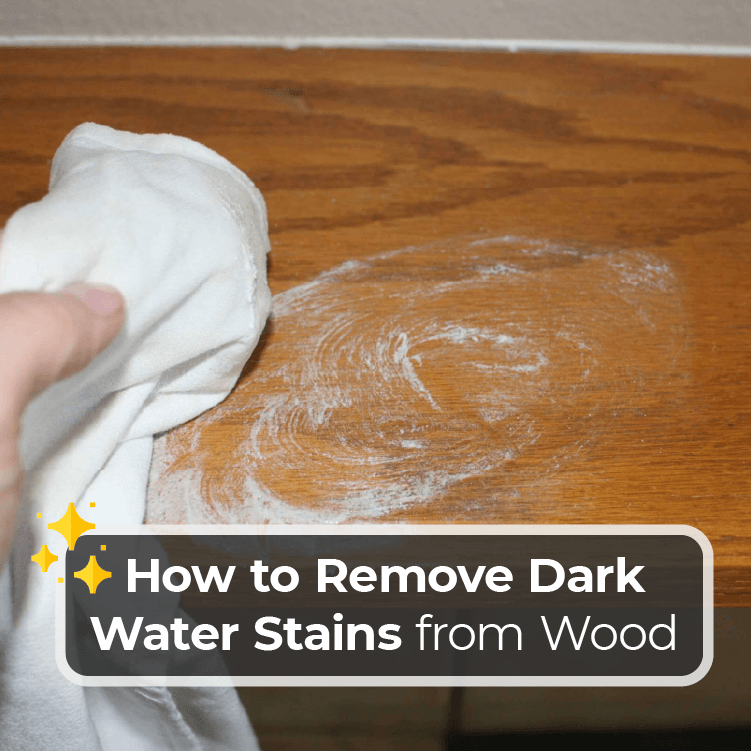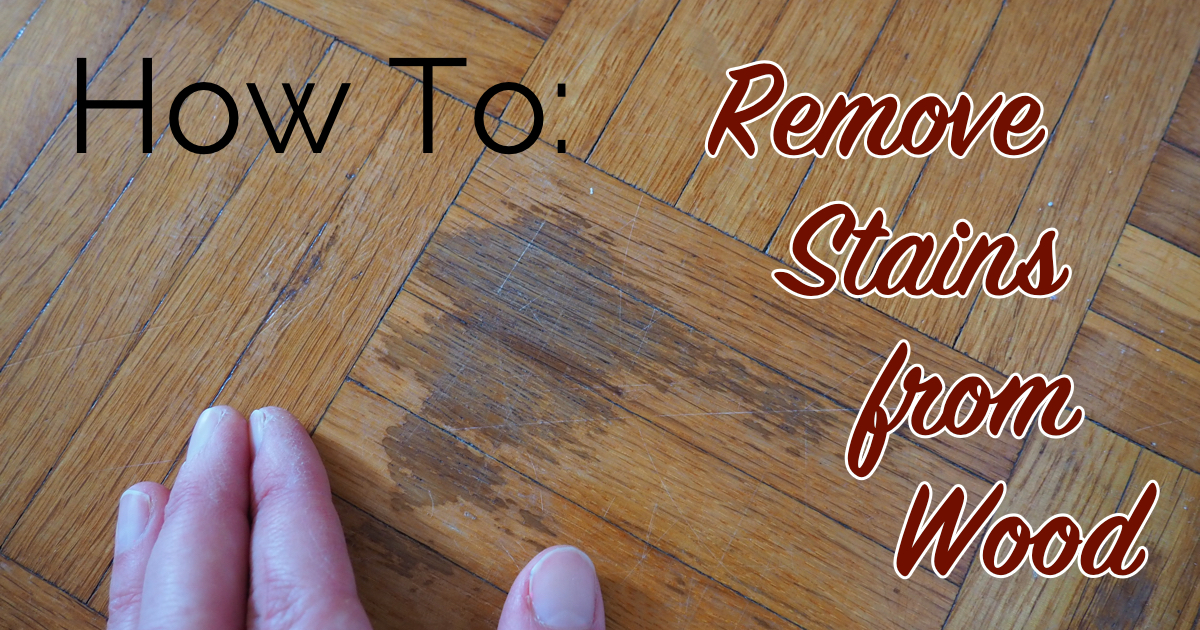Are you frustrated by those unsightly dark water stains on your beautiful wooden furniture? Don’t worry, you’re not alone. Water stains can quickly ruin the appearance of even the most elegant wood surfaces, leaving you feeling helpless and desperate for a solution. But fear not! In this guide, we will explore effective methods and techniques to help you remove those stubborn dark water stains from wood, restoring the natural beauty and luster to your cherished pieces.
Wood is a timeless and exquisite material that adds warmth and sophistication to any space. However, when water penetrates its surface, it can leave behind ugly marks that seem impossible to eliminate. Whether it’s from an accidental spill, a leaky plant pot, or a glass left unattended, water stains can be a real eyesore. But fret not, as we delve into this comprehensive guide, we will uncover practical tips and tricks to banish those dark water stains for good. So, if you’re ready to reclaim the glory of your wooden furniture and restore its original brilliance, let’s dive into the world of stain removal and discover the secrets to revitalizing your wood surfaces.
- Blot the stained area gently with a cloth soaked in white vinegar.
- If the stain persists, mix equal parts baking soda and toothpaste and gently rub it onto the stain using a soft cloth.
- Leave the mixture on for a few minutes, then wipe it off with a clean, damp cloth.
- For stubborn stains, consider using a commercial wood stain remover following the manufacturer’s instructions.
- Once the stain is removed, dry the area thoroughly and apply a wood polish or wax to restore the shine.

How to Remove Dark Water Stains from Wood
If you have noticed dark water stains on your wooden furniture or flooring, don’t panic! With the right techniques and a little patience, you can effectively remove these stains and restore the beauty of your wood. In this article, we will guide you through the step-by-step process of removing dark water stains from wood, ensuring that you achieve the best results without causing any damage to the surface.
Gather the Necessary Supplies
Before you begin the stain removal process, it’s important to gather all the necessary supplies. Here’s what you’ll need:
- Soft cloths
- White vinegar
- Olive oil
- Baking soda
- Hydrogen peroxide
- Wood cleaner
- Wood polish
- Water
Having these supplies readily available will make the stain removal process much easier and efficient.
Assess the Severity of the Stain
Not all water stains are the same, and their severity can vary. Before proceeding with any stain removal method, it’s important to assess the severity of the stain. Light water stains can often be removed with simple home remedies, while more stubborn or deep stains may require professional intervention.
If the stain is relatively new and hasn’t penetrated the wood deeply, there’s a good chance you can remove it using DIY methods. However, for older or more severe stains, it’s advisable to consult a professional wood restoration expert to avoid causing further damage to the wood.
Try the Vinegar Method
Vinegar is a versatile household ingredient that can work wonders when it comes to removing water stains from wood. Here’s how to use it:
- Moisten a soft cloth with white vinegar.
- Gently rub the stained area with the cloth, following the grain of the wood.
- Continue rubbing until the stain starts to fade.
- Once the stain is removed, wipe the area with a clean, damp cloth to remove any residue.
- Finally, dry the wood thoroughly and apply wood polish for added protection.
If the vinegar method doesn’t completely remove the stain, don’t worry. There are other effective techniques you can try to achieve the desired results.
Use Baking Soda and Hydrogen Peroxide
If the vinegar method doesn’t work, you can create a paste using baking soda and hydrogen peroxide. Here’s how:
- Mix equal parts of baking soda and hydrogen peroxide to form a paste.
- Apply the paste to the stained area, making sure to cover it completely.
- Gently rub the paste into the wood using a soft cloth or a sponge.
- Leave the paste on the stain for a few minutes to allow it to work its magic.
- Afterward, wipe off the paste with a clean, damp cloth.
- Repeat the process if necessary until the stain is completely removed.
- Once the stain is gone, clean the wood with a wood cleaner and apply polish for a glossy finish.
Remember to always test any cleaning solution or method on a small, inconspicuous area of the wood before applying it to the stained area. This will help you ensure that the solution doesn’t cause any damage or discoloration to the wood.
Prevent Future Water Stains
Once you have successfully removed the dark water stain, it’s important to take preventive measures to avoid future stains. Here are a few tips:
- Use coasters or placemats to protect wooden surfaces from water damage.
- Wipe up spills immediately to prevent them from seeping into the wood.
- Regularly dust and clean your wooden furniture or flooring to maintain its beauty and prevent water stains from forming.
By following these preventive measures, you can keep your wood looking pristine and minimize the chances of water stains occurring in the future.
Remember, removing dark water stains from wood requires patience and careful execution. If you are unsure or uncomfortable with the process, it’s always best to seek professional help to ensure the best possible outcome for your wood surfaces.
Frequently Asked Questions
Here are some common questions about how to remove dark water stains from wood:
Q: What causes dark water stains on wood?
A: Dark water stains on wood are typically caused by moisture penetrating the surface and reacting with the wood fibers. This can happen when water is left standing on the wood for an extended period of time or when there is a leak or spill that goes unnoticed. The moisture can cause the wood to discolor and form dark stains.
Q: Can dark water stains be removed from wood?
A: Yes, dark water stains can often be removed from wood with the right techniques and products. The key is to act quickly and address the stain as soon as possible. However, it’s important to note that the success of stain removal can vary depending on factors such as the type of wood and the severity of the stain.
Q: How do I remove dark water stains from wood?
A: To remove dark water stains from wood, you can try several methods. One common approach is to use a mixture of equal parts vinegar and olive oil. Apply the mixture to the stain and let it sit for a few hours or overnight. Then, gently rub the area with a soft cloth or sponge to lift the stain. If this method doesn’t work, you can also try using a commercial wood stain remover or a mixture of baking soda and water.
Q: Are there any homemade remedies for removing dark water stains from wood?
A: Yes, there are several homemade remedies that you can try to remove dark water stains from wood. In addition to the vinegar and olive oil mixture mentioned earlier, you can also try using a paste made from baking soda and water. Apply the paste to the stain, let it sit for a few hours, and then gently scrub the area with a soft brush. Another option is to make a paste using equal parts toothpaste and baking soda, which can also help lift the stain.
Q: What should I do if the dark water stain cannot be removed?
A: If your attempts to remove the dark water stain from wood are unsuccessful, you may need to consider more advanced techniques or seek professional help. In some cases, refinishing or sanding the wood surface may be necessary to completely remove the stain. If you’re unsure about how to proceed or if the wood is valuable or delicate, it’s best to consult with a professional furniture restorer or woodworker for guidance.

How To Remove Water Stains From Wood
In conclusion, removing dark water stains from wood may seem like a daunting task, but with the right knowledge and techniques, it is entirely possible to restore the beauty of your wooden furniture or flooring. By understanding the causes of these stains and utilizing various methods such as using household products like vinegar or hydrogen peroxide, sanding, or resorting to professional help, you can effectively eliminate those unsightly marks that mar the appearance of your wood.
Remember, prevention is always better than cure, so it is crucial to take steps to protect your wood from water damage in the first place. This can be done by using coasters, placemats, or tablecloths to prevent water from directly contacting the surface, and by promptly wiping up any spills or moisture. By being proactive and following these guidelines, you can maintain the natural beauty of your wood and ensure its longevity.
In conclusion, with a little effort and the right approach, you can successfully remove dark water stains from wood and restore its original luster. By understanding the causes, utilizing effective methods, and implementing preventative measures, you can enjoy the timeless elegance of your wooden furniture or flooring for years to come. So, don’t let those unsightly stains dampen your spirits – take action and reclaim the beauty of your wood today.
- How to Repair Split Wood Door - April 16, 2024
- How to Fix Gouges in Hardwood Floors - April 16, 2024
- How to Remove Wood Gorilla Glue - April 16, 2024